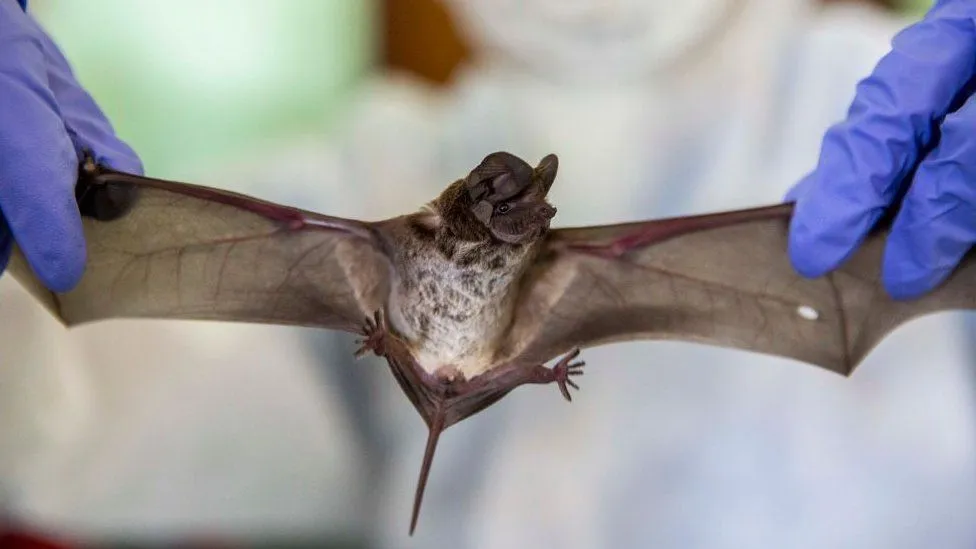The discovery of a new bat virus, HKU5-CoV-2, has captured global attention due to its potential to infect humans and its similarity to the SARS-CoV-2 virus that caused the COVID-19 pandemic. Researchers at the Wuhan Institute of Virology, China, recently published a study in the journal Cell detailing this new virus, which shares the same ability to bind to human ACE2 receptors, the gateway used by SARS-CoV-2. Although no human cases have been reported so far, the virus is seen as a significant find, raising concerns about future zoonotic diseases, where viruses jump from animals to humans.
Discovery and Origins of HKU5-CoV-2
HKU5-CoV-2 was first identified in the Japanese pipistrelle bat species in Hong Kong, later confirmed in various regions of China, including Guangdong, Fujian, Zhejiang, Anhui, and Guangxi. The virus belongs to the merbecovirus subgenus, the same group responsible for the Middle East Respiratory Syndrome (MERS). This family of viruses includes some of the most dangerous coronaviruses in human history. Despite this, no verified cases of human transmission have been recorded yet.
The virus’s spike protein allows it to enter human cells by binding to ACE2 receptors, which also serve as the entry point for SARS-CoV-2. This similarity raised alarms, but researchers have emphasized that the virus has a much weaker ability to infect human cells compared to the highly contagious SARS-CoV-2.
Transmission and Risks
Research into the transmission of HKU5-CoV-2 shows that it can infect human cells and lung tissues in laboratory models. However, the virus’s ability to spread between humans is much lower than SARS-CoV-2, which has been known for its rapid transmission capabilities. In fact, the virus has been shown to have a significantly weaker binding affinity to human ACE2 receptors than SARS-CoV-2. This suggests that while the virus might be able to infect humans, it would not easily spread from person to person.
Despite these findings, scientists continue to monitor the virus’s potential for mutation and its ability to adapt to human transmission. While experts such as Dr. Michael Osterholm from the University of Minnesota suggest that the public reaction to the discovery is overblown, the WHO has already listed merbecoviruses as a priority for pandemic preparedness, indicating a level of precaution in monitoring potential outbreaks.
Expert Opinions on the Virus
Several health experts, including Dr. Sanjeev Bagai, Chairman of Nephron Clinic, downplay the immediate risk posed by HKU5-CoV-2, asserting that it is less infectious and pathogenic compared to SARS-CoV-2. There is no evidence of the virus being passed from bats to humans at this time, and the absence of mutations or significant changes in the virus’s structure further suggests that it poses little immediate threat.
However, researchers argue that the discovery underlines the need for robust surveillance systems for zoonotic diseases. COVID-19’s uncertain origins have made researchers more alert to the possibility of future pandemics originating from animals, making it crucial to stay vigilant in tracking viruses in animal populations and ensuring that any potential threat is swiftly identified.
Treatment and Prevention
Should HKU5-CoV-2 cause human infection, treatments similar to those for COVID-19 may be effective. Monoclonal antibodies and antiviral drugs could potentially help treat the virus, as they have been used for SARS-CoV-2. Monoclonal antibodies specifically target the spike protein of the virus, preventing it from entering human cells. These treatments are commonly used for patients who have weakened immune systems and may not respond to vaccination alone.
On the other hand, antiviral drugs are designed to limit the spread of the virus throughout the body, reducing the severity of symptoms and shortening the duration of illness. These drugs have been used successfully in treating other viral infections, including COVID-19 and influenza. However, as with all viral diseases, the effectiveness of these treatments depends on the strain of the virus and the individual’s health status.
Market Impact and Future Monitoring
Following the announcement of HKU5-CoV-2’s discovery, shares of vaccine manufacturers saw a noticeable rise. Companies like Moderna, Novavax, and Pfizer all experienced increased stock prices, reflecting market concerns about the potential for another pandemic. This also underscores the importance of ongoing research into potential new viruses and the need for continuous investment in vaccine development and antiviral treatments.
Despite the initial market reaction, experts urge caution. While the virus poses an interesting and important subject for research, it is too early to declare any immediate threat. The monitoring and preparation efforts of public health agencies, including the WHO, will be key in managing the situation, ensuring that any potential risks are identified early, and containment strategies are developed promptly.
The discovery of HKU5-CoV-2 has added a new layer of complexity to global health discussions. Though there is no immediate cause for panic, it serves as a reminder of the ever-present threat posed by zoonotic diseases. While the virus is not as capable of spreading as SARS-CoV-2, its genetic similarity to the virus that caused the COVID-19 pandemic means it warrants attention from the global health community. By strengthening zoonotic disease monitoring and improving pandemic preparedness, the world can better respond to any future outbreaks, minimizing their impact on public health and society at large.























